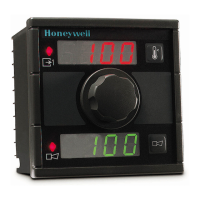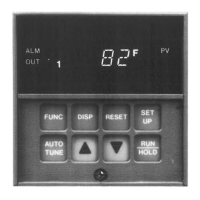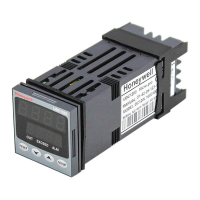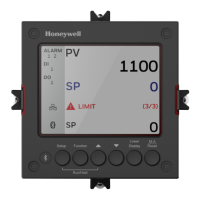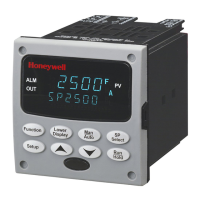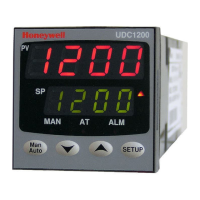36 UDC3200 Universal Digital Controller Operator Manual 04/08
Function
Prompt
Lower Display
Selections or
Range of Setting
Upper Display
Parameter Definition
SUMMER
(See Note 2)
SUMMER WITH RATIO AND BIAS—The following formula
applies:
Alg1=(InpAxRatioA+BiasA)+(InpBxRatioB+BiasB)+(InpCxRatioC+BiasC)+Alg1Bias
HI SEL
(See Note 2)
INPUT HIGH SELECT WITH RATIO AND BIAS—This selection
specifies the PV or SP as the higher of Input 1 or Input 2. The
following formula applies:
Alg1 = higher of (Input A x Ratio A + Bias A) or (Input B x Ratio B + Bias B)
LO SEL
(See Note 2)
INPUT LOW SELECT WITH RATIO AND BIAS—This selection
specifies the PV or SP as the lower of Input 1 or Input 2. The
following formula applies:
Alg1 = lower of (Input A x Ratio A + Bias A) or (Input B x Ratio B + Bias B)
MuDIV
(See Note 1)
MULTIPLIER DIVIDER WITH SQUARE ROOT—The following
formula applies:
Alg1=K*SqRt{(InpAxRatioA+BiasA)x(InpCxRatioC+BiasC)/(InpB*RatioB+BiasB)}
x (CalcHi-CalcLo)+Alg1Bias
MULT
(See Note 1)
MULTIPLIER WITH SQUARE ROOT—The following formula
applies:
Alg1 =K x Sq.Rt.{(InputA x Ratio A + Bias A) x (InputB x Ratio B + Bias B) x (InputC x Ratio C + Bias C)}
x (Calc Hi – Calc Lo) + Alg1Bias
MuDIV
(See Note 1)
MULTIPLIER DIVIDER—The following formula applies:
Alg1 = K x [{(Input A x Ratio A + Bias A) x (Input C x Ratio C + Bias C)} / (Input B x Ratio B + Bias B)]
x (Calc Hi – Calc Lo) + Alg1Bias
MULT
(See Note 1)
MULTIPLIER—The following formula applies:
Alg1 = K x [(Input A x Ratio A + Bias A) x (Input C x Ratio C + Bias C) x (Input B x Ratio B + Bias B)]
x (Calc Hi – Calc Lo) + Alg1Bias
CARB A
CARBON POTENTIAL A—Make this selection if you have a
Cambridge or Marathon monitor type Zirconium Oxide sensor. See
Note 3.
CARB B
CARBON POTENTIAL B—Make this selection if you have a
Corning type Zirconium Oxide sensor. This algorithm requires a
temperature range within the region of 1380 to 2000°F. See Note
3.
CARB C
CARBON POTENTIAL C—Make this selection if you have an
A.A.C.C. type Zirconium Oxide sensor. This algorithm requires a
temperature range within the region of 1380 °F to 2000 °F. See
Note 3.
CARB D
CARBON POTENTIAL D—Make this selection if you have a
Barber Coleman, MacDhui, or Bricesco type Zirconium Oxide
sensor. This algorithm requires a temperature range within the
region of 1380 to 2000°F. See Note 3.

